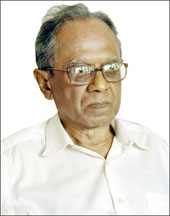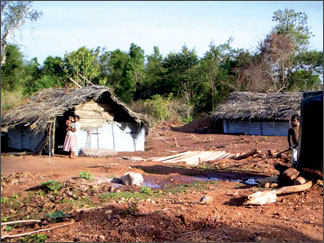MDGs cannot be achieved under current economic growth rates -
Analyst
by Surekha Galagoda and Gamini Warushamana
Profile:
Highest qualification: MA, Econ
Trained in: Advanced Management, Harvard, USA ; Regional Development
Planning, Israel; Small Industry Development, Japan .
|

Lloyd Yapa
Pic: Chinthaka Kumarasinghe |
Experience: Development/Land Officer, RVDB- 64 to 71:
Regional Manager-Southern Province, Director Planning-IDB-71 to 82
Director Policy and Planning-EDB-82-98; Trade Chamber Movement - 98 to
2000
Author: Two books, numerous reports on SME, export development, business
development and over 60 newspaper articles and Volunteer Work-SLEA, OPA
etc.
Sri Lanka will not be able to achieve the Millennium Development
Goals (MDGs) of the UN, especially reduction of poverty levels (at
present around 23% of the population by half) by 2015, unless we
immediately restore ethnic peace and good governance in the country,
economic analyst Lloyd Yapa, told the 'Sunday Observer' .
He said the MDGs cannot be achieved under the current economic growth
rate; poverty is still a worrisome issue in Sri Lanka as statistics do
not show a positive trend in poverty reduction, especially in certain
rural areas, estate sectors and the war ravaged areas of the North and
East.
There was a significant reduction in urban poverty between 1990-91
and 2002. The 1990-91 poverty head count ratio in urban Sri Lanka was
reported at 16.3% and by 2002 it was at 7.9%. This means urban poverty
levels had declined by more than half.
 However, in rural areas there was only a marginal decrease. In
1990-91 the poverty head count ratio was 29.4%; in 1995-96 it increased
to 30.9% and by 2002 it declined to 24.7%. However, in rural areas there was only a marginal decrease. In
1990-91 the poverty head count ratio was 29.4%; in 1995-96 it increased
to 30.9% and by 2002 it declined to 24.7%.
In the estate sector the poverty head count ratio was 20.5% in
1990-91. By 1995-96 it increased to 38.4% and by 2002 it declined to
30%. If we consider the entire country, the poverty head count ratio in
1990-91 was 26% and by 2002 it had declined marginally to 22.7%.
Alarming features
One of the alarming features of poverty in Sri Lanka is declining
nutritional standards. We are proud of our health and education services
but we cannot be so euphoric with regard to the nutritional levels of
the people because the number of malnourished women and children is
reported to be very high (30%).
The infant mortality rate is increasing. Infant mortality at national
level stood at 16% in 1997. In developed countries it was 8%. The estate
sector infant mortality rate was as high as 24%.
In Sri Lanka due to cultural reasons girl-children and mothers get
lower nutrition and this situation could cause grave ill health among
future generations.
The shocking feature is that malnutrition is not going down. Changes
in the consumption patterns seem to have worsened it. Milk powder
consumption is widespread, however it is not the best source of
nutrition. In the rural sector dairy farming and fresh milk consumption
are on the decline. Traditional foods with more nutrition values and
fibre are being replaced by fast foods of no nutritional value.
Literacy rate
Many indicators show that urbanisation decreases poverty as developed
infrastructure and accessibility to essential services improve the
living standards of the people.
 For example the literacy rate in urban areas was 94% compared to
those in rural and estate areas 92% and 77% in 1997; availability of
electricity in urban areas was 88%, rural 56% and estate 12%. The
stunting rate among children aged three to five months in urban areas
was 9.8%, rural 32.8% and estates 33.8%. For example the literacy rate in urban areas was 94% compared to
those in rural and estate areas 92% and 77% in 1997; availability of
electricity in urban areas was 88%, rural 56% and estate 12%. The
stunting rate among children aged three to five months in urban areas
was 9.8%, rural 32.8% and estates 33.8%.
Safe drinking water is available only for about 74% of the households
mainly in the urban areas of the country. This situation causes serious
health issues such as kidney diseases in the Anuradhapura and
Polonnaruwa districts. The recent outbreak of hepatitis in Gampola and
its usual outbreak after the Nuwara Eliya holiday season in downstream
areas are the result of contamination, especially with faecal matter.
Only about 68% of households have sanitation facilities.
The regional disparity in economic growth is growing. The Western
Province contributes more than 50% of the GDP of the country. According
to consumption/income poverty, the Moneragala District is the worst in
the country and in the case of human poverty (inadequate or lack of
access to services such as health and education and social
exclusion/discrimination) the worst area is Nuwara Eliya.
Persistent poverty
Yapa said that there are two main reasons for the persistent poverty
in the country. One is the slow economic growth rate and the second is
the neglect of development of infrastructure facilities and services in
rural areas leading to a severe disparity in income distribution.
Before 1977, the average annual economic growth rate was about 3% and
after 1977 it increased to around 5%. To achieve a higher rate of growth
more investment on a sustained basis is required. Unfortunately our
national savings rate is at a low level - 23.4% of GDP-compared to the
very high rates of around 40% prevailing in East and South East Asia.
Public investment has not been sufficient during the past few years;
it was around 5% compared to over 10% in the 1980s. Today we tend to
reduce public investment to keep the budget deficit lower while
retaining unproductive welfare programs and subsidies to loss making
State owned enterprises, wages to an obese public service, high defence
expenditure and to service the enormous public debt.
The government's welfare programs are poorly targeted due to
politicisation; some people who deserve such payments do not receive
them, while those who are not entitled to receive them are somehow
favoured.
The low level of political stability, infrastructure development, law
and order in the country does not encourage higher investment including
FDI.
Without increasing investment on physical infrastructure and services
such as health and education it is difficult to increase employment
generating opportunities in rural areas.
Certain South East Asian and Far Eastern countries have been
maintaining over 8% annual growth rates over long periods of time due to
investment being around 40% of GDP (compared to around 25% in Sri
Lanka). In 2003 East Asia had attracted FDI worth $53 billion while
South Asia received only $ 5.3 billion of which India accounted for $4.3
billion. FDI is essential as it brings in scarce capital, technology,
skills and knowledge of markets.
The extent of disparity in the distribution of income is clearly
indicated in the poverty statistics, the Gini coefficient being 0.5. (It
is better when closer to zero).
Extreme poverty is prevalent in the estate and certain rural areas
such as Uva and Sabaragamuwa while the people in the Colombo, Gampaha
and Kalutara districts are better off.
Corruption
Another reason for rural poverty is corruption. A study carried out
by the Sri Lanka Economic Association has found that corruption clips
around 2% or more of the country's GDP; it reveals that annually at
least 20% of the capital expenditure of the central and local government
bodies is lost due to bribery and corruption; there are some projects
that are not implemented at all although the contractors are fully paid.
Yapa said that the increase in corruption is mainly due to the
politicisation of the public administration. This is a result of a flaw
in the 1972 and 1977 constitutions. The malaise can be cured mainly by
the separation of the powers of the executive, legislature and the
judiciary; a constitutional revision is needed for the purpose.
If the Executive, more specifically the Public Administration and the
Judiciary are independent of the Legislature, though being accountable,
they will have the space and sufficient freedom (without outside
interference) to maintain managerial standards at a high level.
Another reason for rural poverty is inconsistency in policy
objectives. At macro level the objective of policy is to increase
incomes (and to improve its distribution). But at sector level,
especially in the case of paddy cultivation, the policy is
self-sufficiency and not increasing incomes.
Farmers are not allowed the freedom (over 80% of land being owned by
the government) to select high value crops and are required by policy
makers to cultivate paddy which is not profitable on a small scale (in
fragmented lots).
Land market
Liberalisation of the land market and give ownership of the land to
the farmers will therefore have a significant impact on rural poverty.
The farmers of the unprofitable plots could sell their land so that the
size of holdings and their profitability could increase.
However, there is a fear of immediate selling off the land by
impoverished farmers, thereby enlarging the class of landless peasants.
This can be kept under control by the formation of joint stock
companies (e.g. covering each irrigation system of about 1,000 acres),
where the farmers could be shareholders.
Under this method, the scale of production would be higher and
therefore the unit costs could be kept low; being recognised corporate
bodies, the companies would be able to command all the resources for
acquisition of inputs such as high yielding planting material,
fertiliser, technology, skills, machinery,
processing-storage-transport-marketing facilities etc just like other
well established medium to large business ventures. The lot of the
farmers could be improved by empowering them in this manner.
[email protected]
|
